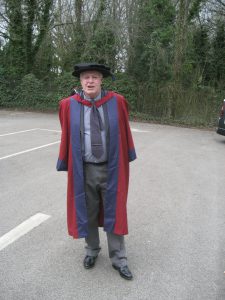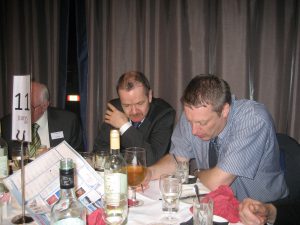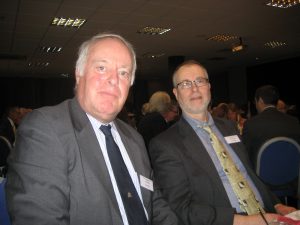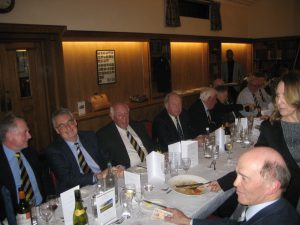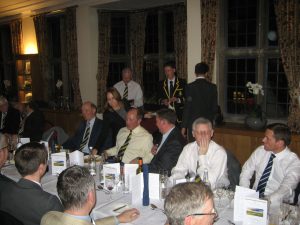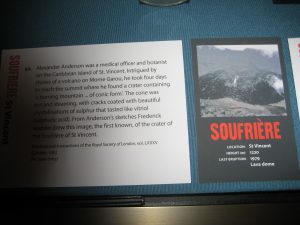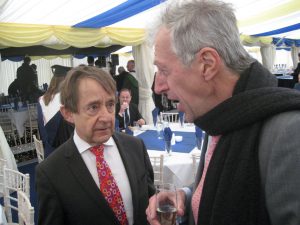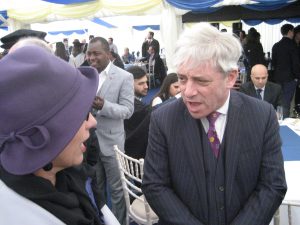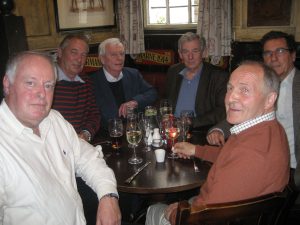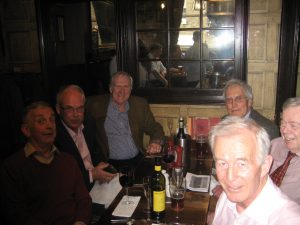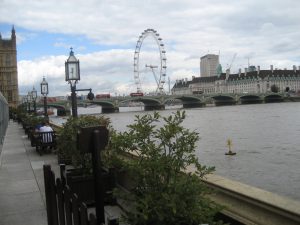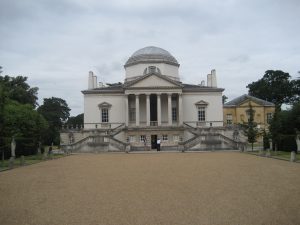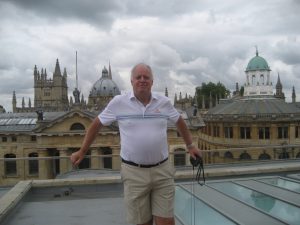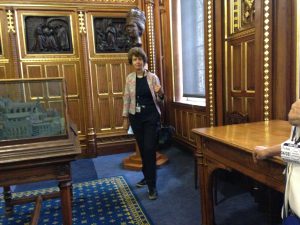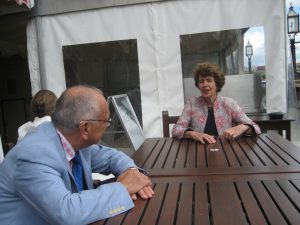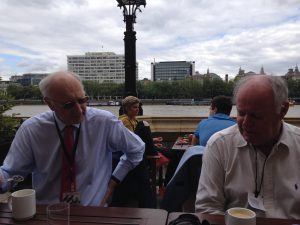(In this instalment, I examine the career of Alexander Foote in detail, and introduce some evidence that he was indeed employed by SIS. For the preceding instalments, please see SoniasRadio.)
In a review of the career of Alexander Foote, and an assessment of whether he was in fact recruited by Colonel Dansey for the latter’s Z Organisation, five major features of his career as a Soviet radio-operator are worthy of attention. One: the sincerity of Foote’s affiliation to communism and the genuineness of his commitment to espionage on behalf of the Soviet cause; two: his role in Sonia’s arranged marriage to Len Beurton, and in her subsequent move to the United Kingdom; three: his connections in Swiss society that enabled him to arrange funding for Radó’s cash-starved network, when paying for Lucy’s expensive services was a paramount concern; four: his identification of the informant known as ‘Lucy’ and his representation of the latter’s activity; and five: the credibility of his ‘defection’ in Berlin in 1947, when on assignment by the Soviets, and the nature of his subsequent interrogation by MI5. In the various accounts of his actions, certain contradictions point to the credibility of the claims for his recruitment by SIS, which, while substantial, unfortunately repose on largely hearsay evidence.
One of the problems is that much of the published material is inherently unreliable. The memoirs of Sonia and Radó have been broadly criticised as being controlled by their Communist masters. Foote’s memoir (which appeared itself in two self-contradictory versions) was ghost-written by MI5, and contains multiple untruths and distortions (to the extent that a verifiable and reliable account of his career does exist). Foote himself told the historian David Dallin that MI5 had ‘mutilated’ his book. Yet several source documents are available that give a more accurate account of what actually went on at the time, even allowing that the authors of such documents may have been distorting some of the facts themselves. (Even British archives may have been doctored!) The files on Foote’s interrogation by MI5 in 1947, and the 1949 report on the activities of the Rote Kapelle – both available at the National Archives – contain enough clues to counter what has for decades been presented as the ‘official’ story of Foote’s life.
The summarisation of Foote’s career – and in the form that Britain’s Security Services would rather have it expressed – runs as follows. He was born in 1905, in Kirkdale, Liverpool. After attending village school in Yorkshire, he was apprenticed to a salesman in Manchester, but joined the R.A.F. in 1935. A year later, however, he left the air force, and volunteered for the International Brigades in the Spanish Civil war, leaving in December 1936. In September 1938, he returned to England with a certificate of discharge on health grounds. On the recommendation of the British Communist Party, he was recruited by agents of Soviet Military Intelligence for unspecified work in Europe. In October 1938 he met Sonia (Ursula Hamburger, née Kuczynski) in Geneva, and early the following year was given training in sabotage for work in Germany. He introduced his International Brigade colleague, Len Beurton, to Sonia, and the two spent several months, primarily in Munich, planning sabotage activity. Recalled just before the war broke out, he and Beurton received wireless/telegraph training from Sonia, who, with her residence visa about to expire, looked for a way of moving to Britain. She arranged a divorce from her husband, and married Beurton. She was able to escape with her two young children via Portugal to Britain in December 1940/January 1941, while her new husband had to remain in Switzerland because of passport and transit problems. Foote became the leading radio operator in the Swiss network of the Rote Kapelle, and was active until the Rote Drei was dismantled, in 1943, through pressure of the Gestapo on the Swiss authorities. After a period in prison, Foote escaped to France in 1944, contacted his Soviet masters, and agreed to return to the Soviet Union, where he was interrogated, but found not guilty of any misconduct. Over two years later, after special training, he was sent to Berlin in the guise of a German, to prepare for a new mission in South America, but presented himself to the British authorities with a desire to defect. He was brought to Britain and interviewed thoroughly by MI5, who then assisted him in the writing of a memoir, Handbook for Spies, and arranged a job for him in The Ministry of Agriculture and Fisheries. Foote eluded any vengeance from the Soviet apparat, but died in August 1956.
The problem with this biography is that at every stage, if one delves a little more deeply, contradictions and paradoxes appear. To start with, Foote’s memoir, ghosted by the MI5 officer Courtenay Young, has massive errors of chronology and fact. As an example, in the first edition, published in 1949, Foote identifies the informant known as ‘Lucy’ as one Selzinger, a Czech who worked for his national General Staff. He describes the one occasion when he met him, after their release from prison in 1944, which is worth quoting (p 178): “A quiet, nondescript little man suddenly slipped into a chair at our table and sat down. It was Lucy himself. Anyone less like the spy of fiction it would be hard to imagine. Consequently he was exactly what was wanted for an agent in real life. Undistinguished-looking, of medium height, aged about fifty, with his mild eyes blinking behind glasses, he looked exactly like almost anyone to be found in any suburban train anywhere in the world.” Apart from the contradiction that Selzinger was both ‘little’ and ‘of medium height’, it is impossible to tell whether this encounter actually happened. Was Foote actually introduced to Selzinger, under the impression that this character was Lucy? Or did he meet the real Lucy (Roessler), believing that his name was Selzinger? Or even in reality meet Roessler, aware of his name and identity, after which MI5 distorted the whole episode with references to Selzinger, as a means of concealing the identity of Roessler (who might turn out to be a not very impressive superspy), in the belief that they could get away with it? The speculation is insoluble. (I shall return to Selzinger later.)
The pit that the officers of MI5 had started digging for themselves became deeper when Handbook for Spies was re-issued, in 1964. It was then graced with a new Introduction (anonymous, but presumably provided by MI5), which informs us that ‘Foote himself is dead: so is the fabulous ‘Lucy’ who even after the war could not refrain from continuing his real – as opposed to cover – occupation and worked for the Czech Intelligence Service’. It then adds blandly: “There have been no alterations to the original text save for the inclusion of Lucy’s real name.” Since the identity of ‘Lucy’ was now known from the trial that Roessler underwent in Switzerland in 1953, the pretence could not continue. (Selzinger was indeed not a pseudonym, unlike other fictions adopted, such as ‘Schulz’ for ‘Hamburger’, but indeed another person. Roessler died in 1958.) Thus Roessler’s name now appears where Selzinger’s was – but the descriptive information for him remains the same. Roessler – who was German, and escaped to Switzerland in 1933 – now becomes a Czech native. Several sentences describing Selzinger’s arrest, and subsequent granting of immunity by the Swiss government, because of his services (p 100), have been deleted. The result is a worse mess than that which appeared in the 1949 version, but for MI5 to attempt to unravel the lies it had told would probably only bring fresh inspection of the case. It was simpler to act as if it were merely a case of mistaken identity on Foote’s part, and to hope nobody noticed the anomalies. MI5 compounded its misjudgment, however, by claiming: “‘Sonia’ is living quietly in England. Foote’s original recruiter [Sonia’s sister, Brigitte] is now living equally quietly behind the Iron Curtain.” Both these facts were wrong. Sonia had rapidly escaped to East Germany after the arrest of Klaus Fuchs, the atom spy. The inevitable conclusion is that anything claimed in Handbook for Spies must be treated with suspicion. Sir Percy Sillitoe, the head of MI5, had to divert a request from the CIA (whose great interest had been provoked by Foote’s memoir) about the possibility of interrogating Foote: “I think Foote’s book should not be taken too literally as questions of detail are not necessarily accurately presented therein.” Indeed, Sir Humphrey.
The reader who is interested in further analysis of the workings behind this clumsy opus is pointed to Chapter 46 of Chapman Pincher’s 2009 book, Treachery, although Pincher concentrates on the cover-up behind Sonia rather than the events in Switzerland. (Intriguingly, Pincher incriminates MI5’s Dick White, who later rose to Director-General, even more than Roger Hollis.) The errors, however, clearly go beyond the deceptions over Sonia’s movements. Thus addressing the conflicts in Foote’s life-story requires a process of triangulation when all three sources of information (Foote’s memoir; the memoirs of others; and archival material) may be flawed. At this stage, when investigating the contradictions and puzzles, I deliberately use very conservatively Read’s & Fisher’s 1981 publication Operation Lucy, which contains (so far as I know) the most detailed account of Foote’s life available in print. While it contains a rich list of sources, and presents an equally deep array of impressive contributors in its Acknowledgments, very few of the facts of Foote’s life are anchored in any of the sources. The five features listed above are now analysed:
1) Foote’s commitment to communism:
Foote’s most significant two colleagues, his boss, Sándro Radó, and the person who trained him, Sonia, both nursed doubts about his ideological commitment. Radó was astonished at Foote’s lack of political education. While admitting his practical strengths, he declared: “ . . . the man had trouble finding his bearings in the complicated international situation and probably had only a vaguest notion of the working-class movement.” When Radó wanted to celebrate the twenty-fifth anniversary of the October Revolution, he turned up at Foote’s flat with a bottle of champagne. Yet Foote showed no recognition of the significance of the occasion. Radó even claimed that he complained to his bosses about the behaviour of ‘Jim’ (Foote’s cryptonym), but his protests were ignored, with Moscow showing an unexplained but maybe consequential confidence in Foote’s bona fides at that time. David Dallin, the author of Soviet Espionage, who interviewed Foote and other agents shortly before Foote’s death, wrote (in 1955): “Rado had no confidence in Foote or his loyalty to the Soviet cause and suspected him of being an agent of the British intelligence service assigned to penetrate the Soviet espionage machine. Rado and a few other members of the group believed that throughout his career, in Spain, in Switzerland, and later in Moscow, Foote had been in His Majesty’s service. ‘I have no documents to prove it,’ says a former member of the Rado network, ‘but I am certain that he was a British agent.’”
As for Sonia, when she first met Foote in 1938, she was impressed. He listened well, and asked good questions, and she concluded that he must be a brave and solid fighter to have joined the Brigades in Spain. (She was writing this account in 1977, long after the time when she learned that Foote had ratted, and was thus known to be a ‘traitor’.) Later, however, Foote prevaricated over the possibility of his marrying Sonia (i.e. before Beurton was selected for this glorious task), and Sonia wrote that he offered up the excuse that he had gone to Spain to avoid a reckless marriage offer he had made to an English girl. Sonia was not pleased. “Either the marriage offer had induced his going to Spain instead of political motives, or he had selfishly worked out an excuse for not committing to what Central wanted,” she wrote. While subtly endorsing the absolute authority of Moscow and its subjugation of personal desires (a point of great importance, as will soon be shown), she at this stage, in the summer of 1939, still did not doubt Foote’s political commitment.
Foote (or MI5) gave a rather unconvincing account of what propelled him towards communism, indicating that he was ‘discontent’ and ‘restless’, but that the Spanish Civil War crystallised his ‘somewhat inchoate thoughts’. The problem with this account is that it completely ignores what the archival evidence shows – that Foote signed up to join the RAF on July 26, 1935, (intriguingly under the name Alexander James Forde), but that the circumstances under which he was discharged were highly ambiguous. One note states that he was declared ‘illegally absent’ on December 23, 1936, the day he left on a one-day excursion ticket for Spain, to join the International Brigades. Foote claimed to his interrogators that he deserted because he was a ‘free-thinker’, and thus presumably not well-disposed to authority. Yet other records indicate that the RAF had no record of his desertion, and that his performance had been considered very satisfactory. His RAF discharge papers state that Foote’s services ‘were no longer required – at his own request’, and his character is identified as being ‘V.G’. No attempt was made to arrest him when he returned to the UK on September 16, 1938, and other notes suggest that MI5 (in the person of Roger Hollis) tried to hush the whole business up, when overeager junior officers in MI5 tried to pin down the RAF on the circumstances of Foote’s dismissal. A note indicates that Hinchley Cooke of C4a in MI5 asked the Home Office to cancel its inquiry into Foote as one of its ‘H.O.S.I.’ (‘Home Office Special Investigation’?) cases. It all suggests an outside agency was at work, that SIS had possibly intervened, and contrived the RAE to give Foote an unofficial discharge.
If anyone was pulling strings, it was a lengthy ordeal for Foote to undergo to build credentials. In his book, Foote gave an authentic account of his work as a battalion transport officer in Spain, and of his introduction to luminaries in the Communist Party movement, including Professor Haldane, and David Springhall, who would help recruit him for his ‘dangerous work’ in Europe on his return to Britain. He claimed that he was sent back on leave in September 1938 to attend the CP Congress in Birmingham. He was not a member of the Party, but his work as a transport worker made him ‘less vulnerable to accusations that he was a “Trotskyist”’. A project for him to work as a courier and smuggler between CPHQ and the battalion in Spain fell through, with the result that his old friend Fred Copeman informed him that the CPGB was recommending Foote for the mission in Europe (i.e. not Spain). Foote wrote that he did not know who his new masters were, but suspected that Copeman was involved with Soviet Military Intelligence. Foote then visited Brigitte Kuczynski in Hampstead (she remained anonymous, and the details in his memoir are wrong about the location) on ‘one fine October morning’, and quickly resolved to accept the assignment after a ten-minute encounter. There was no mention of a meeting with Sonia: he had to make his arrangements quickly, as the meeting in Geneva was in a few days’ time. “I soon found myself on a boat crossing the Channel.”
Here again, the details are unreliable, as the chronology does not fit cleanly. As also explained by David Burke in The Lawn Road Flats, using the Kuczynski files at the National Archives, Sonia returned to the UK in October 1938, and approached Fred Uhlmann, an Austrian Communist who was also a Spanish Civil war veteran. Uhlmann spoke to Springhall, who in turn recommended Foote, whom Uhlmann then interviewed. Foote’s details were passed to Sonia, who had to get approval from Moscow. That having happened, Sonia was told to interview Foote before she returned to Geneva, but Foote was unable to make the appointment because of sickness (as Sonia explains in her memoir). Foote had to meet Uhlmann again at the King Street HQ, and receive his instructions to meet Brigitte instead. This must all have taken some time, yet Foote was issued with a passport on October 12, after travelling to Manchester to have his former bank manager sign his passport application form – an unimaginably speedy process, especially given his background as someone who had recently absented himself from the country to join the International Brigades on a one-day excursion ticket. (To complicate matters further, MI5 believed that Foote and Brigitte had an affair.) Again, he must have had help in high places.
The incongruities in Foote’s account are many. If he was being given a deep cover, he actually showed a lot of resilience in going through with it all, but the hands of the authorities in managing his career are fairly obvious. Admittedly, if SIS did recruit him, it also enjoyed a lot of luck, in that Foote not only turned out to possess the right temperament, he also survived the conflicts in Spain. Yet his commitment to communism was less than red-blooded – a deficiency that will be explored further when his ‘defection’ is analysed.
2) Foote’s role in Sonia’s marriage and move to England:
Foote was eventually installed and trained as a radio-operator under Sonia, after paying visits to Germany to explore opportunities for sabotage. He was recalled just before war broke out, at the end of August 1939, when the implications of the Nazi-Soviet pact were playing havoc on the minds of communists in western Europe. Foote presents the announcement of the pact as a blow to Sonia’s resolve, after which she expressed a desire to Moscow to renounce undercover activities and move to England. In his memoir, Foote asserts that Sonia abandoned her work for the GRU at this stage. He suggests that her bosses in the Soviet Union had some misgivings about her opinions, but that to them a greater obstacle was her lack of papers, and she thus contrived both a divorce from her husband (identified as ‘Schulz’) and an ensuing marriage to Len Beurton, so that she would be given British citizenship, and thus be able to move to the UK. “She continued to obey such orders as she received, but at the first opportunity to the best of her ability she pulled out and returned to England”, Foote’s (MI5’s) account runs, and adds that “there are no Kremlin objections to retirement from the service if circumstances permit and discretion is maintained.” This is, of course, utter nonsense. The decisions of the party were not something between which agents could pick and choose: that would be bourgeois individualism. This account is admittedly echoed elsewhere: Radó gives the impression that Sonia left on her own initiative, and it is also possible that the Soviet Archive has been doctored to distort the truth. Yet Sonia would not have made any move without Moscow’s explicit permission.
One of the on-line readers of Sonia’s Radio (who wishes to remain anonymous) has given me a translation of a letter that Sonia was purported to have written to Moscow Centre in late August 1939, where she makes the suggestion that she divorce officially [sic] from Rolf (Rudolf Hamburger) and marry Jim (Foote) or John (Beurton). She tells them that she is ‘on firm footing’ in Switzerland (not true, as her residence pass is about to expire), and that her husband works as an architect in China (maybe not true, as she claimed in her memoir that he had just left Switzerland at that time, but certainly superfluous information, since Rolf also worked for the GRU, and Moscow would know what he was up to since it had ordered him to move there, and forced their separation). Yet her supposed letter strongly implies that it is her objective to continue her espionage work in Britain, and my contact comments that when she explained her predicament to Beurton, “Sonia said that in the interests of the future struggle with fascism, she needed to move to Britain”, thus confirming that she was still committed to espionage. In an extraordinary reversal of roles, the file indicates that Moscow goes along with Sonia’s plan – which, as will be shown in a later instalment, had been hatched some time beforehand.
Sonia’s record, in Sonjas Rapport, tells a different story. She had a worthless, expired German passport: she had been given permission by the Swiss authorities to stay only until the end of September 1939. At the beginning of 1939, Moscow Centre therefore sought possibilities for her gaining another passport, as it had fresh plans for her. At the same time, her marriage with Rolf was breaking up: as a symptom, her second child, Nina, had been fathered by Ernst, a fellow-spy in China. At the same time, Rolf was preparing to return, by order of Moscow, to China. According to Sonia, Rolf agreed to a divorce, and Sonia was instructed to marry one of the Englishmen (Foote or Beurton). She decided that Foote was more suitable, because of his similar age, and Foote consented to the plan. In another melodramatic twist (again in Sonia’s account only), Rudolf and Ernst visited her in August 1939, just before they jointly left for China, where Rudolf would be subordinate to Ernst, and Ernst here encountered his daughter for the first and only time. Sonia saw them both off at the railway station, and maybe allowed herself a single bourgeois tear. Yet the M15 report on the Rote Kapelle, written in October 1949, indicates that Rolf had arrived in Hong Kong in June 1939, so Sonia’s description of a sentimental reunion in August sounds very dubious. Is the Soviet archival piece more authentic than her memoir? Both show strong signs of disinformation.
Matters continued to get complicated. Sonia began to express a greater liking for Beurton than she had had for Foote, since Len was more sentimental, and loved both nature and her children. What is more, Foote was having second thoughts about the marriage, bringing up the story of his possible breach of promise, and he recommended that she marry Beurton instead. This is the occasion where Sonia expressed her doubts about Foote’s commitment, but she moved on, and the divorce came through at the end of the year. The fact that her Swiss pass had expired by then is overlooked in her narrative, but she does describe the problems she had trying to establish the legal basis on which a marriage between two persons whose countries were at war could be arranged. Moreover, she admitted that many sham marriages were going on at the time in Switzerland with the purpose of gaining British passports. It is very difficult to imagine Sonia getting her marriage approved, and her passport issued, without some generous assistance from the British Consulate in Berne. (I shall explore this part of the adventure in a future instalment.) Yet all the necessary documents became available for her marriage on February 23, 1940, and Sonia admits that she was brash enough to tell the Consulate that the reason for her marriage was to gain a British passport. On May 2, 1940, she held the papers in her hand.
The story is not yet complete, however. Foote’s evidence given to his interrogators at MI5 is not entirely reliable (as when, for example, he states that Sonia’s had requested to be posted to the USA after the signing of the Nazi-Soviet pact), but one remarkable statement arising from his interrogation by MI5 is so outrageous that Foote could have served no purpose in inventing it. In a memorandum dated September 17, 1947, he is reported as admitting that it was on his false testimony that Sonia obtained her divorce in the Swiss courts. “When I asked him what was the false evidence he had produced”, so MI5’s Serpell’s account runs, “he said that it had been a story of Rudolf Hamburger’s adultery with one of Sonia’s sisters in a London hotel. I asked which sister was selected for this episode and Foote replied, Mrs. Lewis [Brigitte].” (Coincidentally, Sonia’s narrative informs us that Brigitte was also visiting her in August 1939: did she help hatch the story herself?) This revelation indeed caused a massive re-think for Serpell, since it was he and Jim Skardon who had discussed the divorce with Sonia and Beurton at Great Rollright in Oxfordshire just four days earlier, and noticed the pair’s discomfiture. Yet Serpell still concluded that Sonia had not been involved in any espionage since she arrived in the country six years before. (On this delusion, more in a later instalment.)
The significance of this episode is great for other reasons. First, it suggests that the Swiss authorities needed more than a statement from Rolf that he approved the divorce, and also that they were probably unaware of the parentage of Sonia’s daughter. Yet unless Foote made a special return visit to the UK in 1939 (when there is no evidence that Rolf was in the country: on the contrary, Sonia says he was building up a false identity in France at the time), he was induced to perjure himself based on an imaginary event that would have had to happen a long time before. And the Swiss presumably accepted his evidence. On the one hand, in her version, Sonia probably wanted to avoid the sordid aspects of the whole affair, and show that Rolf’s agreement to the divorce was adequate justification for the Swiss authorities to approve it, when, in actual fact, Swiss law no doubt required some evidence of adultery (as was the case in Britain). Moreover, Foote told his interlocutors that Hamburger knew nothing about the divorce. If Rolf had been around in Switzerland at the time, it would clearly have been easier to manufacture the scene closer at hand. On the other hand, it was evidently very important to some influential British authority that Sonia secure her divorce, undertake her marriage, and gain entry to Britain, and it appears that Foote was organised to play a role in lubricating the event. Indeed, if Foote was entrapped by this ruse, it explains how MI5 was able to maintain another hold over him during his awkward time remaining in Britain after 1947. Moreover, the machinations behind the scene might suggest that SIS (if it was indeed pulling the strings) was not very excited about the prospect of Foote’s marrying Sonia, since it would remove him from a vital position within the Soviet spy network. Thus it probably coached him on an alternative plan.
Foote also admitted to the historian David Dallin that he knew the true motivation behind Sonia’s escape. In an interview on October 31, 1953, as Read and Fisher note, he told the historian that Sonia was transferred to England by her bosses. He does not declare outright that the purpose of her mission was to operate as an intermediary for Klaus Fuchs, but he does state that was what her role evolved into. Foote was a very bitter man by then: he felt monstrously abused by MI5, who had butchered his account of his experiences in Switzerland and in the Soviet Union, and he felt that British Intelligence had failed to act on all the warnings he had given them about the activities of the GRU in Britain. The evidence points to the fact that he been shamefully used, and that his grimy involvement in perjuring himself was a major reason why MI5 was able to maintain a hold over him.
3: Foote’s Swiss Connections:
Given Foote’s educational background, one of the more remarkable aspects of his career in Switzerland was his ability to find funding sources for the cash-starved network. That he did effect such a project seems certain. Handbook for Spies relates how, working with Radó, he convinced Moscow that arranging for funds to be transferred by the offices of American firms, at discounted exchange rates, would be a secure way of addressing the problem. Moscow agreed to his ideas. Radó says little about it, as it would clearly have indicated that he was not in total control. All he did admit was: “Jim had his radio-operating, and in addition Central set him special assignments that were not directly connected with the work of his group.” Radó had earlier admitted that Foote was ‘resourceful and ingenious when it came to tackling problems of a technical or economic nature’, but that is all. He was no doubt not very pleased with the fact that Jim had his own set of codes, and carried on conversations with Moscow Centre of the content of which he had no idea.
Part of Foote’s alibi to conceal his role as an illegal radio-operator was to set himself up as a rich but not very healthy ex-patriot. In this guise, he had several society friends. Indeed, Sonia indicates that he was having some kind of affair (‘ein Flirt’) with the sister of the Romanian Foreign Minister, whom he presumably met when, in the early days of the war, Moscow was suggesting that the whole apparat be moved to Bucharest – a transfer that was abandoned when the Germans invaded Romania. Foote claims he used such connections to advance the financial cause: “I made some discreet enquiries among my more monied Swiss friends and the shadier of my English acquaintances, and soon evolved a scheme which I thought would work. Through the agency of a Swiss friend I was able to get in touch with some firms which in the course of their normal business remitted money between Switzerland and the U.S.A.” (The Rote Kapelle files at Kew indicate that one of the companies used was the R.K.O. Pictures organisation: it is worth noting that Claude Dansey was a director of Alexander Korda’s London Films, and that Korda made regular visits to Zurich, partly on Dansey business. The connection may be significant.) In any case, Foote’s admission suggests that he must have been well-known to the British Consulate, who should no doubt have been making inquiries as to why this Englishman was resident in Switzerland, and not contributing to the war effort. Foote expands his story: “I then delved into the dim twilit world of the local black bourse and discovered that there were a large number of individuals who had friends in America who were prepared to take the place of my well-established firms and quite certain that their relatives would not question a sudden windfall of a few thousand dollars to the credit of their relative in Switzerland.” How this earthy and uneducated man (his ghost-writer, Courtenay Young, called Foote ‘well-nigh illiterate’, which was probably a bit unfair) suddenly acquired such polished skills is never explained.
In fact, rumours circulated in the circles in which Foote moved that he was a spy, and, in Guy Burgess-like fashion, he would refuse to deny them as part of the façade. David Dallin reports that, after Foote’s book was published, the Gazette de Lausanne ran a series of stories on several of his friends, accounts that contributed to his image as an eccentric but very likeable exile. Radó reports that this rumour went further than society friends. As he wrote, in a variation of Sonia’s story: “According to Jim the Lausanne authorities were under the impression he worked for British intelligence anyway. He had heard about this from the wife of the Rumanian minister of economic affairs [an almost exact echo of Sonia’s reference], a lady who visited Lausanne occasionally and from whom Jim had elicited quite a lot of useful information. On this occasion she had smilingly confessed over a glass of wine that her friend, the wife of the Rumanian ambassador, harboured this suspicion and had apparently communicated it at a diplomatic reception to one Colonel Perron of Swiss Counter-intelligence.” Radó indicates that Foote had been wise enough to report this impression to his bosses in Moscow. It was a wonder that they perceived the irony, that being a dangerous commodity in the offices of the Lubianka.
It is quite extraordinary that a) a person of Foote’s background would be able to manipulate such a deal, and b) the scheme would not have come to the attention of Swiss or British authorities. Did Foote possibly receive help from SIS? David Dallin’s testimony suggests he may have done. In the early 1950s, Dallin performed interviews with several people related to the Rote Drei and its network, one of whom was a lawyer, Roger Corbaz, who had been the presiding judge of the Swiss Military Tribunal that heard the case when Foote was tried in absentia, on October 30, 1947. Dallin relates that the money-transferring scheme was working quite satisfactorily, until a hitch occurred, some time in 1943. In order to try to fix the problem, Foote went to see a lawyer in Lausanne, to gain help in the transfer of a large sum from the United States, and brought along with him a British intelligence agent. In Dallin’s words: “Sensing something suspicious in Foote’s story, the lawyer told his new client: ‘I will arrange the transfer if you will bring proof that the money, deposited as you say in an American bank, belongs to you, and that the affair is clean and honest.’ Foote never reappeared.” Yet Corbaz himself may not have been entirely clean. The National Archives show SIS’s report on Foote’s trial in Lausanne (which a representative from SIS attended), where Corbaz stopped a court reader from calling out Foote’s list of contacts. Foote told Jim Skardon of MI5 that Corbaz had been involved with him in a black-market transaction just before he was arrested, and was thus probably embarrassed ‘in sitting in judgment in a case to which he had himself been a guilty party’. Foote nevertheless received a sentence of two-and-half years’ imprisonment, with an 8000 Franc fine, and confiscation of property. It is not surprising that he declined to attend.
The second major episode where Foote’s connections with the British Consulate came into play occurred when the spy ring was being hunted by the Gestapo, which was applying pressure on Swiss Security to identify and close down the Rote Drei. The way that Foote tells the story, the initiative came from Radó, who suggested seeking a safe house with the British – whether because he knew of Foote’s connections, or simply because the United Kingdom was a military ally, is not certain. Moscow Centre turned the idea down imperiously, suspecting Radó of, at best, ‘leanings towards the democracies, and at the worst downright treachery’. Radó himself had a different spin: he said that Foote brought him a message from Moscow advising them to ask ‘our friends’ for help. Justifiably, he wondered who such ‘friends’ might be. Not the Swiss Communist Party, for sure, as contact was forbidden. According to Radó, Foote then came up with the notion that Moscow might mean the Allies’ embassies in Berne, and Radó implies that Foote’s reputation would have played to good advantage. But Moscow found the suggestion completely unacceptable, and ordered him to go underground.
Radó’s ignorance of what was going on must also be questioned. His intermediary (at two levels of separation) with Roessler was a woman called Rachel Duebendorfer, who was working both for the Soviets and the British. She stubbornly refused to identify to Radó or to Moscow who Lucy was, but MI5’s file on Karel Sedlacek (aka Selzinger) states that in 1943 or 1944, Duebendorfer ‘reported to our Geneva representative that RADO’s W/T [wireless-telegraph] had broken down and that he had a lot of material which he did not wish to be lost to the Allied effort and which she passed to us on his behalf on the strict understanding that we did not report the fact to Moscow.’ Radó did not operate a wireless apparatus himself, but by then his operators had become compromised or captured. It was a big risk he took, defying his Moscow bosses by seeking assistance from the hated imperialists, and the action may have brought him into trouble later.
The conclusion must be that Foote enjoyed at least an unofficial solid relationship with the British authorities in Switzerland. And they, in turn, would have been very obtuse if they had ignored the rumours circulating, or were too idle to investigate what a character with Foote’s background was performing in those circumstances.
4) Foote’s Awareness of Lucy:
It is a fruitless endeavour to try to depict accurately the web of relationships in the intelligence world of Switzerland in WWII. Which informants were working for whom, who out of ideology and who for pecuniary reasons, who were merely couriers and intermediaries, who was officially on a foreign payroll, what information was fresh, which invented, who in Swiss Intelligence connived at the activities of foreign networks, how they held off the Nazis, which way intelligence was passed. Nor is it clear exactly how information was communicated, which radio sets were clandestine and which official and approved, or whether encrypted cables were being detected. Indeed, some recent opinion suggests that the whole reputation of the Rote Kapelle was boosted to impressionable allied officers by German intelligence experts anxious to curry favour, an initiative that only helped the post-war reputation of the Soviet Union. Yet a segment of the whole imbroglio can be taken under the microscope, based on the evidence that the CIA and British Intelligence gained from interrogations and captured German documents, the testimony of Foote, and other MI5 and SIS records.
One critical question to be posed is: why did MI5 allow the notion to be aired that Lucy was in fact Selzinger, instead of Roessler? This raises subsidiary questions, such as that raised earlier in this piece: whom did Foote really meet in 1944 – Selzinger or Roessler? And how much did he know about Roessler’s identity before then? The reasons these questions are important is that the account that Foote purportedly gives of Lucy’s activity in 1941 is probably wrong, as Radó and other sources have confirmed that Lucy was not recruited as an informant to the network until September 1942. Yet it is possible, as the head of intelligence in the Czech government-in-exile, Frantiśek Moraveč, claimed in his memoir Master of Spies, that Roessler was working for the British before then, using Sedlacek as a wireless-operator. The CIA Report asserts that this was so, that Sedlacek started reporting to London in September 1939, and his source was ‘Lucy’ [sic: a possibly very telling anachronism!]. It adds that he was activated and identified by the Communist ring only in September 1942 (i.e. when the ULTRA project incidentally took on life). The CIA Report points to the German transcriptions of the intercepted traffic as proof that Lucy’s material did not go to the Soviets until late summer of 1942, after Duebendorfer established the relationship. But that is not proof. The historical focus on when ‘Lucy’ became known to Radó (and to the Gestapo) has diminished the role he may have previously played with Sedlacek and Foote. Sedlacek (or the Czech transmitting station at Woldingham) was almost certainly sending Roessler’s reports not just to London, but also to Moscow well before Moscow Centre became aware of ‘Lucy’s’ existence. If the Czechs were informing the British, they were surely informing the Soviets at the same time. That would explain why Foote (among others) made the claim – to Serpell during questioning – that ‘Lucy’ was active earlier than 1942, and that Moscow had been warned by Roessler of Hitler’s coming invasion in 1941. ‘Lucy’ was Roessler, but Roessler was not always ‘Lucy’, although the nickname may have anteceded his engagement by the Soviets.
Moreover, even though Foote was a radio-operator, and had his own codes, the intelligence that would have been passed to him (from Roessler to Schneider to Duebendorfer to Radó to Foote) would have been encrypted before it was given to him. Thus, if he were solely a Soviet-controlled operator, he would not have known at the time which messages were derived from Lucy’s sources, even though his memoir indicates the contrary. Moreover, when he finally met ‘Lucy’ (whom he might have heard of by repute), the book reports that he described him as less than average height, an assessment echoed by Dallin, although Dallin may have been merely repeating what Foote told him. Yet the few existing photographs of Roessler suggest a man of above average height. Perhaps Foote was introduced to Selzinger as a Lucy impostor (if indeed his account of the encounter is true) by arrangement of the British authorities, or maybe MI5 again just wanted to divert attention from Roessler when they massaged Foote’s testimony into his ‘memoir’. It is more likely that he knew them both.
By now, readers will be familiar with the claim that Malcolm Muggeridge made, reinforced by Read and Fisher, that Roessler was working for the British, as was the friend of his intermediary, Sissy Duebendorfer. In that case, MI5 was playing a dangerous game in presenting Selzinger as the vital link in the chain. It cannot be that they seriously believed that Selzinger was Lucy: the 1949 file on the Rote Kapelle clearly indicates that Roessler was the man behind the cryptonym. At that time, however (i.e. two decades before Muggeridge’s revelations), MI5 might have believed that there was too close a link between Roessler and SIS in Geneva to declare openly Roessler’s identity. Alternatively, they may have received pressure from SIS to confuse the issue. Claude Dansey had sadly died a few months before Foote’s return, and was thus out of the picture. The text of Handbook for Spies was correctly passed to SIS before publication in 1949. Yet it was strangely signed off by Maurice Oldfield, who had joined the service only after the war, and was then only deputy to the head of counter-intelligence. (For some reason, Serpell had chosen to write to Oldfield about Foote’s case in November 1947.) Oldfield informed Reed of B2A that he could see no objection to its publication, but admitted that Colonel Vivian had not yet seen it. While he would later become director-general of SIS, at that time Oldfield could probably could not tell a Selzinger from a Seltzer. There is no evidence that Kenneth Cohen (Dansey’s deputy, who denied to Nigel West that Foote was ever recruited by SIS) saw the draft of the book. That was an extremely careless move by SIS.
One major cause of a possible exposure was that Selzinger had probably been in the employ of SIS himself. MI5 was not aware of that fact at the time, but a later investigation, in 1953, caused the Security Service to make a request to the Home Office about a British passport that had been issued to one Karl Sedlacek in the name of Charles Simpson. Eventually, MI5 was able to gain the following admission from SIS: “Sedlacek was a Czech Intelligence agent to whom we gave cover in 1939 and issued a British passport in the name of Mr. SIMPSON. . . . . to enable him to carry out a mission in Switzerland on behalf of the Czech Intelligence Service.” Why would the issuance of a British passport have been necessary to allow a Czech officer to work for the Czech Intelligence Service in a foreign, neutral country? SIS went on to state that, on one occasion when Sedlacek’s own wireless broke down in Switzerland (about 1941 or 1942), he requested that ‘our Geneva station’ transmit a quantity of material on his behalf. So why would SIS need to give Sedlacek cover? After all, he was a member of the Czech Intelligence staff, and in regular contact with Moraveč back in London. Was it perhaps so that he would be immune from prosecution, and would be able to be spirited back to the UK should a catastrophe happen, and the Nazis invaded Switzerland? Yet Moraveč wrote that Sedlacek moved painlessly from Czechoslovakia to Switzerland without having to go via London. The CIA Report makes no mention of Sedlacek’s being in England in May 1939 (when his UK passport was issued), but does puzzlingly state that ‘Sedlacek came to Switzerland (from Prague) with a British passport’, elsewhere saying that this was in June 1937. It states clearly that he was moving from Zurich to Lucerne in the spring of 1939. Again, it is a colossal muddle.
Another enigmatic entry in Foote’s archive reflects an interest expressed in March, 1952, by the French Embassy, who believed that a man called Simpson had been an agent of Foote in the Rote Kapelle, based on something Foote had said. The note goes on to indicate that Foote had stated (when, and to whom, is not clear) that ‘a certain Jean BOHNY was in 1942 instructed by Moscow to go to an address in St. Gallen and ask for “Charles SIMPSON” from whom he would obtain a short-wave wireless transmitter.’ These nuggets strongly suggest not only that the Czechs in London were in close communication with their Soviet friends (no revelation, this), but that Sedlacek was exercising his identity as a Briton at this time. Moscow should by all accounts have been advising its agents to stay well clear of any British intelligence operatives. Were the Czechs the ‘friends’ recommended by Moscow above? If so, why would Sedlacek masquerade as Simpson? The incident also sheds doubt on the story proposed in Handbook for Spies that Foote met Selzinger for the first time in 1944. It is all very bewildering – as it is no doubt intended to be.
Moreover, could Foote have been ‘our Geneva station’ as well as a Soviet radio operator? The authorized history of SIS suggests that its wireless capabilities in Geneva had been emasculated. Keith Jeffery writes: “There was a SIS wireless set at Geneva, but it could be used only for receiving messages as the Swiss authorities did not permit foreign missions in the country to send enciphered messages except through the Post Office . . . Cypher telegrams could still be sent, but they ran out of one-time pads. Thus only messages of highest importance could be sent: much intelligence reached London only after delay. Lack of continuous secure communications meant London was unable to send out any signals intelligence material.” One should point out that Jeffery is being very evasive and disingenuous: the Swiss authorities turned a blind eye to such foreign transmissions, so long as their originators were not working against Swiss interests. They understood the common fight against the Nazi threat. Thus Jeffery’s account should probably not be taken very seriously. And indeed, he never explains how the problem was resolved, although by July 1943, he implies that it must have mysteriously been addressed. He writes that the Abwehr spy, Hans Gisevius, considered that the communications channels of Allen Dulles, the Switzerland-based representative of OSS (the American equivalent of SIS) were so insecure that he advised the American to pass the information through British channels – which he did. It is not beyond the bounds of possibility to think that Foote’s equipment could have been used for official British purposes.
The result of this investigation is inevitably inconclusive, and may never be resolved satisfactorily. Yet it does point to a good deal of awkwardness on the part of British Intelligence in dealing with their activities in Switzerland, and a desire to muddy the waters as far as Foote was concerned. As indicated, Foote became immensely frustrated with the obtuseness he encountered in MI5, but one telling statement he made is recorded in his file: “During the war, you see . . . . information . . . . always looked upon by the Russians, more or less ran the war; it was an awful big . . . Telegrams . . . to station; very important . . . especially the way we handled it, a marvellous affair.. At least . . . the way the information came, wonderful information.” Even this apparently highly edited fragment, a strangled mixture of pride and apology, seems to point unswervingly to Foote’s involvement with a Greater Game of Ultra distribution administered by SIS.
5: Foote’s Defection and Interrogation:
Given Foote’s remarkable escape from Switzerland to Paris in November, 1944, several questions arise concerning his motivations and objectives in reaching a safe haven, and his experiences thereafter. Why did he report to the Soviet Embassy, instead of trying to gain safety and liberty with the British? When he returned to Moscow, and was interrogated about his activities, why did the Soviets later send him back on a mission to Germany with a clumsily fake identity? When Foote then decided to ‘defect’, why was the GRU apparently so insouciant about his disloyalty? Why did they not eliminate him? And why, if he truly had been an SIS employee, did the service apparently disown him, and do nothing to protect him?
Three scenarios present themselves for the original approach to the Soviet Military Mission. One, Foote had always been a dedicated and obedient Communist agent, and any other course of action would have been out of the question. Two, he harboured severe doubts, valuing his freedom, but the fear of being hunted down in the West by GRU assassins was a less appealing prospect than facing the music with his bosses in Moscow. Three, he was instructed by SIS to continue the deception, and prolong his role as a Soviet radio-operator. From what is known about his character and associations, the first seems very unlikely. Foote liked his creature comforts, and he surely knew enough about life in the Soviet Union not to risk a sojourn to a place from which he might never return, no matter how strong his communist convictions might have been. He had helped the Allies win the war, and could probably expect a sympathetic hearing back in the United Kingdom. The second scenario is plausible: Foote had an exaggerated view of his own importance, considering himself the leader of Radó’s ring once the Hungarian had disappeared, and he claimed in his memoir that he had ‘voluminous’ information picked up from Roessler and another informer, Pünter, known as Pakbo, that he needed to pass on to Moscow. Maybe he expected a hero’s welcome, but also an opportunity to set the record straight with Moscow Centre (who was upset about the collapse of the Swiss network) before Radó had an opportunity to pitch his version. He also entered the Soviet Embassy with the goal of persuading them that the Swiss network could easily be resuscitated. That last fact might play into the third scenario: that SIS was very keen to see the deception maintained, and Foote to return to his role in Switzerland. Moreover, a breach in Foote’s commitment at this stage might have blown the whole operation, and drawn attention to Sonia’s enigmatic presence in England. Thus SIS might have strongly urged Foote to continue to work with the GRU, not realising that an order to go to Moscow was the outcome. And in a casual aside to Serpell that tells volumes, Foote made the ‘curious remark’ (in Serpell’s words) that he thought ‘the British would like him to go there’.
In fact both Foote and Radó were summoned to Moscow for ‘consultations’. Foote had considered all the options (so his ‘memoir’ claims), but he decided that, with the war still unfinished, he ought to see the project through, and defend himself. Readers may inspect Handbook for Spies to learn what he underwent in Moscow, but the outcome was that he managed to convince Poliakova and her successors (as she was purged after the Gouzenko affair) that he was not an agent provocateur, and even stressed, with true revolutionary ardour, how he wanted to continue the subversive campaign back in the West, noting, however, that ‘my first six weeks in Moscow had convinced me that Nazi Germany as I had known it was a paradise of freedom as compared with Soviet Russia.’ His story must have been persuasive. After undergoing intense training, he was established with a new identity – a German called Albert Mueller, born to an English mother, who was commissioned to set up a new espionage network in Argentina. Foote, who spoke poor German with an English accent, was instructed to spend six months in Berlin to strengthen his credentials. He left Moscow in early March 1947, and, after some curious experiences in Berlin, he entered the British Zone on August 2.
Why would the GRU send Foote on such a perilous and leaky expedition? Is it possible that they planned his defection, so that he could protect Sonia by reinforcing to British Intelligence the fact that she was a harmless ex-spy? Why did they not assassinate him? In Chapter One of his book, Foote writes (again, if we can trust that the words are his): “When I walked out of the Soviet Zone and gave up my career as a Russian spy I was as surely condemned to death by the Russians as any criminal by a black-capped judge and through the due processes of law. The Soviet system knows only one penalty for failure or treachery – death.” But Foote was not killed, even though in the years after the war the Soviets did hunt down and kill multiple traitors or failures. Why would they be indulgent with him after they realised they had been hoodwinked at least once – by Foote’s blatant mendacity in Moscow, and probably by the deceptions played by the British in Switzerland? Is it possible that Foote was really a ‘Spy who Returned from the Cold’, and who was directed to re-insert himself in the British intelligence structure in order to distract attention from the pursuit of atomic secrets that Sonia was managing? Klaus Fuchs had returned from the USA to the UK in the summer of 1946, and had taken up a position at AERE Harwell. The possibility should not be discounted: David Dallin raises the idea, and even suggests that some British intelligence officers (who were sympathetic to Moscow) considered he might be a plant with an assignment to ‘worm his way in’.
When Foote was repatriated to the UK, it was MI5, not SIS, who interrogated him. It appears that SIS disowned any knowledge of him. That would have been necessary, of course, in order to maintain the fiction that he had not been under its control in Switzerland. Moreover, Claude Dansey had died on June 11, 1947, and was not around to take an interest. While Read and Fisher express surprise that Vanden Heuvel and Farrell (Dansey’s deputies in Switzerland) should have spoken up for him, any such action would have been a clear signal to the Soviets that their suspicions were justified. On the other hand, MI5 seemed bewildered by his experiences, and Foote was clearly threatened that he should keep silent about his experiences. One remarkable entry in the record of his interrogations (in this case, by Serpell and Hembly-Scales), in September 1947, runs as follows: “Essential he make no references to his connections with British Intelligence. I went on to emphasise that this was a general reservation and Foote’s associations with British Intelligence were not to be mentioned to anyone. I did not want to seem disloyal to Mr. Vesey, but Foote would understand that it was not safe for him to speak of British Intelligence interests even to this recommended firm of publishers! Foote lapped up this story and asseverated several times that he would never speak to anybody about his life with us or of our past interest in him . . . Concluding, I told Foote that if he were to represent himself in any way as an assistant, past or present, of British Intelligence we were likely to hear it.” This statement crisply merges SIS and MI5 in the identity of ‘British Intelligence’. The message could not be clearer.
Obviously, as some commentators have suggested, MI5 had some power over Foote. Malcolm Muggeridge saw him as a broken man who was frightened of the Security Service. There was the possible dishonourable discharge from the Royal Air Force. There was the act of perjury in the matter of Rolf Hamburger and Sonia’s sister. And, to his credit, Serpell brought up the fact that acting as a Soviet spy when the Soviet Union was allied to the Germans during the time of the Nazi-Soviet Pact was not an action to be taken lightly by the British authorities. So Foote only hinted at the connection with Z and SIS, in asides which the censors of the archive thankfully did not delete. Contrary to what his memoir says, he assuredly did warn that Sonia was still linked to Moscow, and actively involved in espionage, although his interlocutors softened the message in their transcripts. Foote even indicated that Sonia’s brother Jürgen (a communist agitator and spy) was angry about Sonia’s return as a penetration agent, since it might have compromised the political work of the Kuczynski clan. He also provided further evidence by showing how the Soviets had invoked the help of Elinor Rathbone (the leftist activist) to enable Beurton to join his wife in England in July 1942.
Yet, despite Serpell’s sensible recommendations for following up Foote’s accusations about Sonia and her family, MI5 seemed bewilderingly slow to follow up, as if his well-articulated suspicions about Sonia were being stifled by its senior officers. The MI5 report on the Rote Kapelle, dated October 17, 1949 astonishingly states that Ursula Beurton ‘is not known to have engaged in any subversive activity’ between 1941 and that date. (This trend would reach ludicrous proportions later, when, after Fuchs’s trial, junior MI5 officers made recommendations to question Sonia further, unaware that she had fled the country several months before, immediately Fuchs had been arrested.) MI5’s chief counter-espionage officers Liddell and White withheld Foote’s testimony from Percy Sillitoe when the painful Fuchs post-mortem occurred. On the other hand, Foote apparently made a gesture to protect his former collaborators. In her book, Sonia relates a strange episode whereby Foote turned up at the house of a comrade (almost certainly Ullmann), and whispered urgent warnings that Sonia and Len should be very careful, stop work, and destroy everything. It would probably be accurate to attribute this activity to another ruse devised by SIS to reinforce the image of Foote as a confused patriot who still wished his communist friends well. No doubt Moscow got to hear of it.
Moreover, Foote displayed rather shocking Fascist sympathies to his interrogators. It was one thing to have doubts about the theory and practice of Communism, but it was another to suddenly veer towards the Fascist version of totalitarianism. A conversation between Foote and his sister on September 12, 1947, bugged by MI5, alarmingly showed that Foote compared the current British treatment of Germany unfavourably with the humanity of the Germans, and that he considered stories of Nazi atrocities to be greatly exaggerated. Radó drew attention to Foote’s ‘volte-face’, as Foote ‘sank back into the swamp of petty-bourgeois existence’. But this was worse, and could not be ascribed simply to ignorance and disdain for the practice of Communism. Indeed, Foote’s ideological weakness had been on display earlier: he confided to Serpell that he and Beurton had discussed working for the Nazis at one time in 1938, when they were in Munich together. Serpell even came to the conclusion that Foote might have had ‘some conscious connections with representatives of the German Intelligence in Switzerland’. Foote was assuredly a mixed-up case.
Yet Foote’s frustrations with the obtuseness of MI5 about communist subversion persisted, and, in the years after, he took his suspicions about infiltration in the service to a broader audience, writing letters to MPs, and even (according to Read and Fisher) demanding that a committee of Privy Councillors should investigate why his information had been ignored. But no one paid attention to him. His book was published, he was given a job in the Ministry of Agriculture and Fisheries, and his health declined. In 1955, Dallin published his book in which he indicated that Foote had approached Corbaz with a member of SIS. If Moscow Centre had picked that up, it might have concluded that Foote was not just a traitor, but a pernicious double-agent. At that time, as Boris Volodarsky informs us, the GRU was using poisons such as thallium to kill traitors in western Europe in a way that made the affliction look like severe gastritis. In any case, Foote was recorded as dying in August 1956 in University College Hospital, London, of acute peritonitis due to a perforated duodenal ulcer (Tarrant). Another account says he tore off his bandages in frustration and pain. Yet another claims that he did not die until several years later. The photograph of him at that time (see http://www.gettyimages.com/detail/news-photo/british-spy-alexander-foote-circa-1955-foote-worked-in-news-photo/80302908#british-spy-alexander-foote-circa-1955-foote-worked-in-switzerland-as-picture-id80302908 : from 1955) would seem to portray a man much older than the fifty-one-year-old he would have been in 1956, but maybe his trials had worn him out by then. In any case, MI5 was probably not sorry to see him out of the picture, and Moscow would not have regretted his passing.
The conclusion must be that a large array of evidence points to the fact that Foote was not a naïve romanticist who was captivated by the idea of communism, and worked innocently as a radio-operator for the Soviets in Switzerland until his spell in the workers’ paradise convinced him the cause was unjust. He was an untutored adventurist, a mercenary. And he was manipulated in other ways, by a shady British intelligence service who lured him with its unique version of adventure, in which he was taken advantage of for some greater scheme which has never seen the light of day, but which probably involved inveigling Sonia back to the UK so that her wireless transmissions could be monitored, and maybe her cohorts in espionage unveiled. For that reason, the work of Read and Fisher – based so much on informal anecdote and guidance – needs to be reassessed very seriously. In the next instalment of Sonia’s Radio, I shall return to the persons who provided the information that supported their argument, before turning back to Sonia’s extraordinary escape and charmed life in the United Kingdom.
New Sources:
Central Archive of the Ministry of Defense of the Russian Federation (at second hand)
The SIGINT Secrets by Nigel West
The Lawn Road Flats by David Burke
Dealing with the Devil by Dónal O’Sullivan
The Red Orchestra by V. E. Tarrant
The KGB’s Poison Factory by Boris Volodarsky
P.S. Towards the end of the month, I received from the New York Public Library some extracts from the Dallin Papers that I had ordered. I did not have time to analyze them before compiling this instalment. Moreover the notes that Dallin took are primarily in Russian and German. My understanding of German is still decent, but my Russian, after nearly fifty years of disuse, is patchy. I shall need to spend some further time on what Dallin recorded. Yet one comment he made stood out immediately. He startlingly describes on one page, when outlining the flow of information from the German Higher Command, that it passed by ‘Rössler-Selzinger – Lucie’. Is this making an equivalence of Rössler and Selzinger as being one person?? If so, that would explain a lot of the conflicts in Handbook for Spies. Could Sedlacek (Selzinger) conceivably have been set up by Czech and British intelligence as a German with the name of Rössler? A photograph from Selzinger’s British passport application (Simpson) would probably confirm or refute such a theory immediately. I wonder whether anyone out there can shed any light on this matter. Does anyone know more about Sedlacek? If so, please let me know. (March 2)
(This month’s new Commonplace Entries can be found here. I have also added a sprinkling of new Hyperbolic Contrast examples noted since last September, which are located here.)

